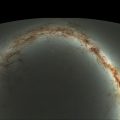
A circle marks the faint and distant galaxy illuminated by the dying star. Newly discovered, this galaxy is as yet unnamed (Image courtesy Edo Berger)
An international research team led by Edo Berger of Harvard-Smithsonian Center for Astrophysics, made the most of a dying star’s fury to probe a distant galaxy some 9.5 billion light-years away. The dying star, which lit the galactic scene, is the most distant stellar explosion of its kind ever studied. According to Berger, “It’s like someone turned on a flashlight in a dark room and suddenly allowed us to see, for a short time, what this far-off galaxy looks like, what it is composed of.”
The study, published recently in The Astrophysical Journal, describes how the researchers used the exploding star’s light (called an ultra-luminous core-collapse supernova) as a probe to study the gas conditions in the space between the host galaxy’s stars. Berger says the findings reveal that the distant galaxy’s interstellar conditions appear “reassuringly normal” when compared to those seen in the galaxies of our local universe. “This shows the enormous potential of using the most luminous supernovae to study the early universe,” he says. “Ultimately it will help us understand how galaxies like our Milky Way came to be.”
The discovery of the dying star in this distant galaxy was made using images from the Pan-STARRS1 survey telescope on Haleakala in Maui, Hawai’i. “Pan-STARRS is pioneering a new era in deep, wide-field, time-critical astronomy — and this is just the beginning,” says John Tonry, one of the study’s co-authors and supernovae researcher at the University of Hawai’i at Manoa’s Institute for Astronomy.
After the Pan-STARRS discovery, spectroscopic follow-up studies using the Multiple Mirror Telescope in Arizona and the 8-meter Gemini North telescope on Mauna Kea, Hawai’i provided the data used by the team to probe the gas of the distant galaxy’s interstellar environment. The spectra revealed the signatures of a distant ultra-luminous supernova, and equally important, the unique fingerprints of iron and magnesium within the distant galaxy that hosted the explosion. The galaxy itself contains a very young population of stars (~15 to 45 million years old) with a mass totaling some 2 billon Suns.
The ultra-luminous supernova explosion belongs to a relatively recently-identified and special breed of exploding stars. They are some 10-100 times more luminous than their ordinary less-energetic cousins and unusually blue in color. While the process leading to their demise is still being explored, evidence points to the central core-collapse of a star having as much as 100 times the mass of our Sun. The collapse triggers an enormous explosion that blasts prodigious amounts of heavier elements through the star’s enormous outer layers before expanding into space.

The Pan STARRS1 survey telescope in Hawaii.
“The beauty of studying distant galaxies using ultra-luminous supernovae as a tool is that it eliminates the need for satellites and offers more time for study,” says Alicia Soderberg of Harvard University. “A typical ultra-luminous supernova can take several weeks to fade away.”
The study by Berger and his team provides the first direct demonstration that ultra-luminous supernovae can serve as probes of distant galaxies. Their results suggest that with the future combination of large survey and spectroscopic telescopes ultra-luminous supernovae could be used to probe galaxies 90 percent of the way back to the Big Bang.





